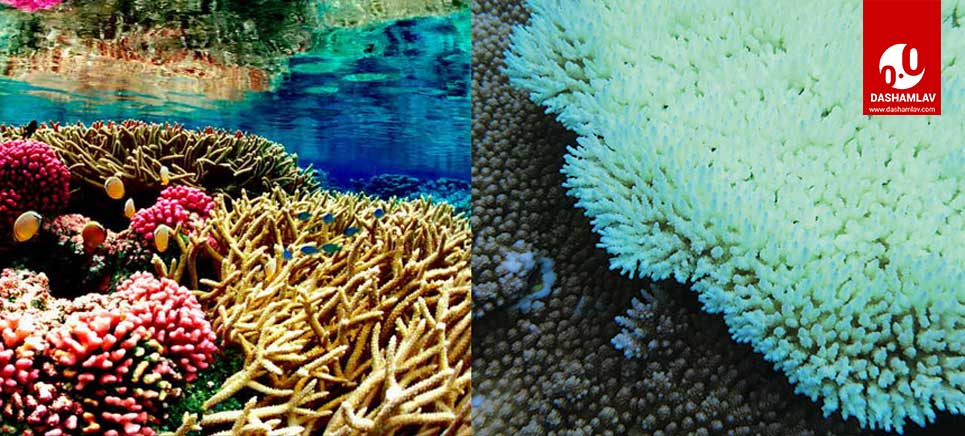Coral Bleaching is the phenomenon of whitening of the corals. The vibrant color of the corals comes from Zooxanthellae, the marine algae which live inside the coral tissue. Corals (bundle of genetically identical tiny organisms called Polyps) have a mutualistic symbiotic relationship with these microscopic algae called the zooxanthellae. The corals provide the algae with the compounds necessary for photosynthesis and in return get their easy nutrition and stunning colors. Changes in external conditions such as temperature, nutrients, or light put the corals under stress. The stressed corals react by expelling the zooxanthellae out of its tissue. The loss of pigment-producing zooxanthellae leaves the coral with the pale white color of its translucent tissue of calcium carbonate.
Causes of Coral Bleaching
Climate change and rise in temperature is cited as the main cause of Coral Bleaching. But, Coral Bleaching has numerous other reasons as well.
- Rise in the temperature of oceans – Most of the coral species live close to the warmest temperature they can tolerate. This means that the slightest increase in seawater temperature, say by 2 degrees Fahrenheit, can cause the coral to expel out the algae and thus turn pale white.
- A sudden drop in temperature – Though normally rise in temperature is seen as the cause of coral bleaching, a sudden drop in temperature too lead to coral bleaching. Corals have relatively narrow temperature margins.
- Ocean Acidification – Oceans being the carbon sink are absorbing the rapidly increasing amount of carbon dioxide in the atmosphere. As a result the ocean water is turning acidic. The acidic water reduces the calcifying ability of the corals thus misbalancing the symbiotic relationship of polyps and zooxanthellae.
- Solar Radiation and Ultraviolet Radiation – Ultraviolet radiation as well as solar radiation instigates coral bleaching. Changes in the tropical weather pattern that reduces the cloud cover increases the amount of solar and UV radiation.
- Bacterial Attack – Pathogenic bacterium like vibrio shiloi inhibits the process of photosynthesis by zooxanthellae thus disturbing the coral. An increase in sea temperature increases the risk of coral being attacked by such bacteria or other infectious diseases.
- Inorganic Nutrients – Chemical pollution in sea or ocean waters disturbs the nutrient balance of the coral’s ecosystem. The inorganic nutrient concentration promotes the growth of phytoplankton thus creating competition for space. Chemical pollution can also decrease coral’s resistance to diseases.
- Increased Sedimentation – Various human activities increase the rate and quantity of sedimentation which can affect corals in many ways. Sediments can inhibit photosynthesis by reducing the amount of light available to corals or simply smother the corals by settling over them.

Apart from the above-mentioned reasons, many other human activities like over-fishing, coral mining, etc. disturb the ecosystem of coral; thus resulting in coral bleaching.
Effects of Coral Bleaching
Coral bleaching is a matter of concern for the world because this does not simply mean a change in the color of corals. The whitening of coral does not only starve it to death but also affects our ecological as well as economical balance.
The coral reefs provide food and shelter to about 25% of all marine species. So, coral bleaching will affect a quarter of marine species directly and disturb the food chain and food web of which these species are part. This disturbs the ecological balance. The disturbance in the food web of the marine species would directly affect the livelihood of fishermen. Further, this will affect the food supply and other related activities.
Vibrant colors of the coral reefs are an important attraction for divers and other tourists too. Bleaching can adversely affect the tourism sector of such an area giving a further setback to the economy.
Coral reefs also play their part in protecting the coastlines by absorbing constant wave energy. This keeps the people living nearby safe from frequent storm damages. So, coral bleaching can strip the coastal areas of a natural line of defense against massive sea storms.
Use the citation below to add this article to your bibliography
"Coral Bleaching: Meaning, Causes and Effects." Dashamlav.com. Web. 27 July 2024. <https://dashamlav.com/coral-bleaching-meaning-causes-and-effects/>
Dashamlav.com, "Coral Bleaching: Meaning, Causes and Effects." Accessed 27 July 2024. https://dashamlav.com/coral-bleaching-meaning-causes-and-effects/
"Coral Bleaching: Meaning, Causes and Effects." (n.d.). Dashamlav.com. Retrieved 27 July 2024 from https://dashamlav.com/coral-bleaching-meaning-causes-and-effects/
